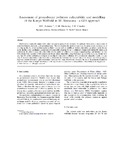Assessment of groundwater pollution vulnerability and modelling of the Kanye Wellfield in SE Botswana—a GIS approach

View/
Date
2004Author
Alemaw, B.F.
Shemang, E.M.
Chaoka, T.R.
Publisher
Elsevier Science Ltd, http://www.elsevier.com/locate/pceType
Published ArticleMetadata
Show full item recordAbstract
Botswana is a semi-arid country with limited recharge to groundwater resources. Groundwater however is a major source of
water for domestic, industrial and agricultural uses. There is therefore the need to ensure that the groundwater resources are of
drinking quality, by protecting them against pollution sources such as landfills, pit latrines, industries, agricultural pesticides and
waste. In this study a preliminary assessment of vulnerability of groundwater to pollution in Kanye well field in SE Botswana is
undertaken. In order to assess the vulnerability of this aquifer to pollution, soils types, mapped geology and information from
82 boreholes were input into a GIS system to classify pollution vulnerability using Theissen polygons of the study area. Results indicate
that 58% of the well field area is highly or very highly vulnerable to pollution, 34% is moderately vulnerable to pollution, and
only 9% has low vulnerability. Estimates of the aquifer media characteristics in areas with only a few observations or few geological
logs were considered to have higher uncertainty than areas with many observations. However, the use of the polynomial estimator enabled consideration of simple uncertainty for the aquifer media characteristics and pollution vulnerability modelling process.
